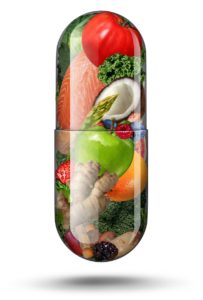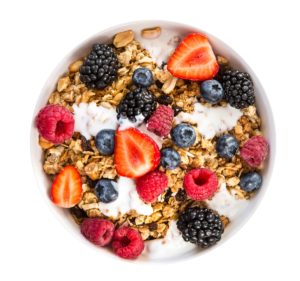Client Handouts/Tips for Clients
Question of the Month
It will soon be easier for consumers to make better food and beverage decisions when eating out or on the go. The U.S. Food and Drug Administration (FDA) has moved forward with a food labeling law that requires restaurants, grocery stores and convenience stores with 20 or more locations to post calorie counts for standard menu items. Proponents say calorie disclosures on everything from muffins to lattes to Happy Meals will offer more transparency and will likely encourage diners to downsize their consumption.
Food, Not Pills
Count this as more proof that we shouldn’t rely on pills and powders to make up for dietary shortfalls.
Are Healthy Eaters Wasteful?
Eating a diet based on whole foods deserves a thumbs-up. What’s hard to swallow, however, is that doing so might contribute to the heaps of food wasted in the United States.
Keto—Fat Chance of Performing Better
The ketogenic diet, a fat-forward meal plan that limits followers to about 20 grams of daily carbs, may help some people shed a little weight (in the short term), but it might not be good news for their athletic pursuits.
Plant Foods Are Good for Our Gut Bugs
Our bodies host a huge population of microorganisms, dubbed the human microbiome. In recent years, the makeup of critters in our guts has been linked to a plethora of conditions, including depression, heart disease and obesity. And now bug-friendly scientists at the University of California, San Diego School of Medicine have presented initial findings from the American Gut Project, a crowdsourced initiative that analyzes people’s survey responses and fecal samples to better understand how things like diet, lifestyle and disease affect the human microbiome.
Belly Fat vs. Vitamin D
Here’s another good reason for people to reduce their Buddha-bellies: improving their vitamin D status. According to data presented at the 2018 European Society of Endocrinology’s annual meeting in Barcelona, Spain, researchers from the Netherlands found that more body fat around adults’ waistline is associated with lower vitamin D levels. Beyond raising the risk of weak bones, poor vitamin D status could set the stage for other health issues, including heart disease and compromised immunity.
Ask the RD
Question: I have a sensitivity or allergy to tomatoes. My mouth and esophagus get itchy and sore when I eat them. Is there any way to make tomatoes less irritating? Is there a good substitute for tomatoes in recipes?
Answer: You may suffer from oral allergy syndrome (OAS), a relatively common reaction to plant foods, including tomatoes. People who have pollen allergies are more likely to have OAS (Asero 2013) because they react to similar proteins in vegetables, fruits and/or nuts.
Time to Snub the Clubs?
The prospect of getting extra bang for their food buck has more people perusing
warehouse-style club stores like Costco and Sam’s Club. But the urge to stockpile large amounts of food in the house may lead to calorie overload.
Portion Distortion
No wonder social media feeds are packed with pictures of overflowing smoothie bowls: It appears people feel the types of foods they consume play a bigger role in their health goals than the volume they eat. As a result, a study from Vanderbilt University published in Management Science suggests that those who are trying to maintain a healthy body weight or wishing to shed a few pounds might be prone to overeating “healthy” items like nuts, granola and avocados. The upshot: The public should be educated about practicing portion control—for foods of all kinds.
Snacks Are a Workplace Hazard
Many people can’t resist the temptation of homemade chocolate chip cookies in the break room or leftover Halloween candy circulating among the cubicles. A Centers for Disease Control and Prevention study of 5,222 employees across the U.S., using data from the U.S. Department of Agriculture’s National Household Food Acquisition and Purchasing Survey, documented this challenge.
Exercise and the Gut Microbiome
New research suggests that endurance exercise positively affects the gut microbiome, but only for lean individuals and only for as long as exercise continues. Researchers at the University of Illinois at Urbana-Champaign conducted the study with 32 sedentary men and women—some lean, some obese. The purpose was to explore the impact of endurance exercise on the composition, functional capacity and metabolic output of gut microbiota. Investigators collected samples from the subjects before and after 6 weeks of exercise, then after 6 weeks of no exercise.
Obesity Linked to Lack of Sleep in Childhood
Enforcing bedtime rules may be an important factor in helping kids maintain healthy weight levels. A comprehensive research review of 42 studies with 75,499 participants, conducted by University of Warwick researchers in Coventry, England, found that short sleep durations in infants, children and adolescents were a risk factor for gaining weight and developing obesity. Data analysis showed that children and teens who slept less than others of the same age gained more weight as they grew older and were more likely to become overweight or obese.
The Importance of Exercise for Addiction Recovery
Substance use disorder can wreak havoc on people’s lives. Fitness activity can be a
transformative way for those in recovery to heal, rebuild their lives and find a community of healthy supporters.
According to a study published in Mental Health and Physical Activity in 2011, patients with substance use disorder who exercised while in recovery reported feeling greater strength, improved health, a sense of accomplishment, and increased confidence about staying clean and sober.
Comprehensive Research Project on How to Create an Exercise Habit
24 Hour Fitness® is partnering with the University of Pennsylvania Behavior Change for Good Initiative [BCFG] to support research into what works best for creating lasting exercise habits. With an interdisciplinary team of world-renowned researchers, the BCFG addresses the broader question of how to make positive behavior change stick in aspects of life related to health, education and savings.
The Connection Between Inactivity and Obesity
Can we say that inactivity and obesity are directly related? Scientists are still addressing this issue. The 2018 Physical Activity Council Participation Report shows that 82.4 million people—28% of the American population—are inactive. At the same time, the Centers for Disease Control and Prevention reports that more than one-third (36.5%) of U.S. adults are obese (NCHS Data Brief, No. 219, November 2015).
Question of the Month
When you offer training advice to clients, are you discussing the significance of sleep? If yes, are you using sleep trackers and monitoring results? Please describe how you are educating clients regarding the role of sleep in effective training and weight management and share any success stories you have had.
Share your responses with executive editor Joy Keller, [email protected].
Exergaming May Improve Independence Among Older Adults
Maybe you’ve thought about integrating exergaming—exercise combined with video games and other elements of technology—into some of your classes or sessions. Don’t forget to include older adults. A recent study found that seniors with mild cognitive impairment (MCI), a precursor to Alzheimer’s, showed significant improvement in certain complex thinking and memory skills after exergaming.
Equal Calories Burned ≠ Same Results
Many people fixate on the number of exercise calories they burn. New research, sponsored by Les Mills International, shows that even when two group fitness activities (indoor cycling and a resistance workout) were matched for duration and caloric expenditure, they did not have equivalent metabolic effects—which could influence long-term training results. Lead study author Nigel Harris, PhD, said, “The type of exercise used to burn those calories . . . impacts the long-term positive effects that exercise has on the body.”
How to Help Participants Find Flow
For a moment, think about your own workouts. Tap into that feeling of being completely absorbed in your favorite fitness routine. Everything else fades away, and your entire focus is on the present moment. You feel confident in your body’s abilities, you’re challenging yourself, and you find great meaning in what’s happening now. You’re in the zone. Before you know it, your workout is over, and you can’t wait to do it again.
An Eye on Vision Health
When it comes to muscles, we rarely think about our eyes, and yet the eye is the fastest and most active muscle in the human body (VSP 2018). We say “in the blink of an eye” for a reason! While you probably don’t program “eye lifts” into your strength training routines, exercise does support healthy vision. Read on to find out more about the benefits, along with a few fun facts you can share with clients to further inspire them to keep moving.

















